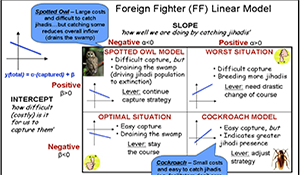Deterrence in the 21st Century: Volume II


Deterrence in the 21st Century: An Effects-Based Approach in an Interconnected World Volume II - Typologies.
Author | Editor: Chesser, N. (DTI).
This Deterrence Typology was created to assist in the development of deterrence options and plans for State and Non-State Actors. It can be used as a stand alone document for identifying important information to characterize and understand State or Non-State Actors. It can also assist in the development of initial questions that should be answered about either type of actor to be deterred.
This typology represents the merged product of three separate efforts to identify and categorize (a) the most relevant factors influencing the behavior and decisions of State and Non-State Actors and (b) the underlying elements of Decision Making by individuals and groups. Because it is the product of negotiation and consensus, some of the detail and richness of the descriptions developed specifically for State and Non-State Actors has been lost. However, the resulting merged product should be more valuable as a single resource for either type of Actors.
The section on Decision Making and the Decision Maker should help the user better understand which elements of the previous sections may be most influential in a specific scenario or situation and how they may impact the Decision Maker’s behavior. While the section on Decision Making Approaches may be one of the most important for understanding and affecting an Actor’s decision calculus, the information needed to make a determination about an approach may be difficult to ascertain without sufficient information about previous decisions made in a variety of situations and about the current context. Although a set of implications for each decision making style has been included to aid analysis and development of potential deterrence options, it is recommended that the user vet decision making approach determinations with appropriate subject matter experts.
This typology is organized into five (5) sub-typologies deemed relevant to describing the factors likely to impact an actor’s decision making process about a particular issue or action. The five sub-typologies are: Objectives, Motivation, Capabilities, Functional and Structural Environment (including the physical and human terrain), and Decision Making (see Table of Contents – next page). The overall format of the Deterrence Typology provides a brief definition of each sub- typology followed by a list of indicators of the sub-typology and observables. Suggested collection and analysis sources are enumerated under the observables.
The Deterrence Typology should be referred to for additional detail, definitions, and examples before and during completion of the Guiding Questions.
Collection & Analysis Caveats:
- Collection sources are representative versus exhaustive.
- “Analysis” implies the use of content analysis, pattern analysis (including nodal), trend analysis, change detection, and anomaly detection. Any additional factors are directly noted in the relevant section.
See the Annex for Information Sources and Methods
